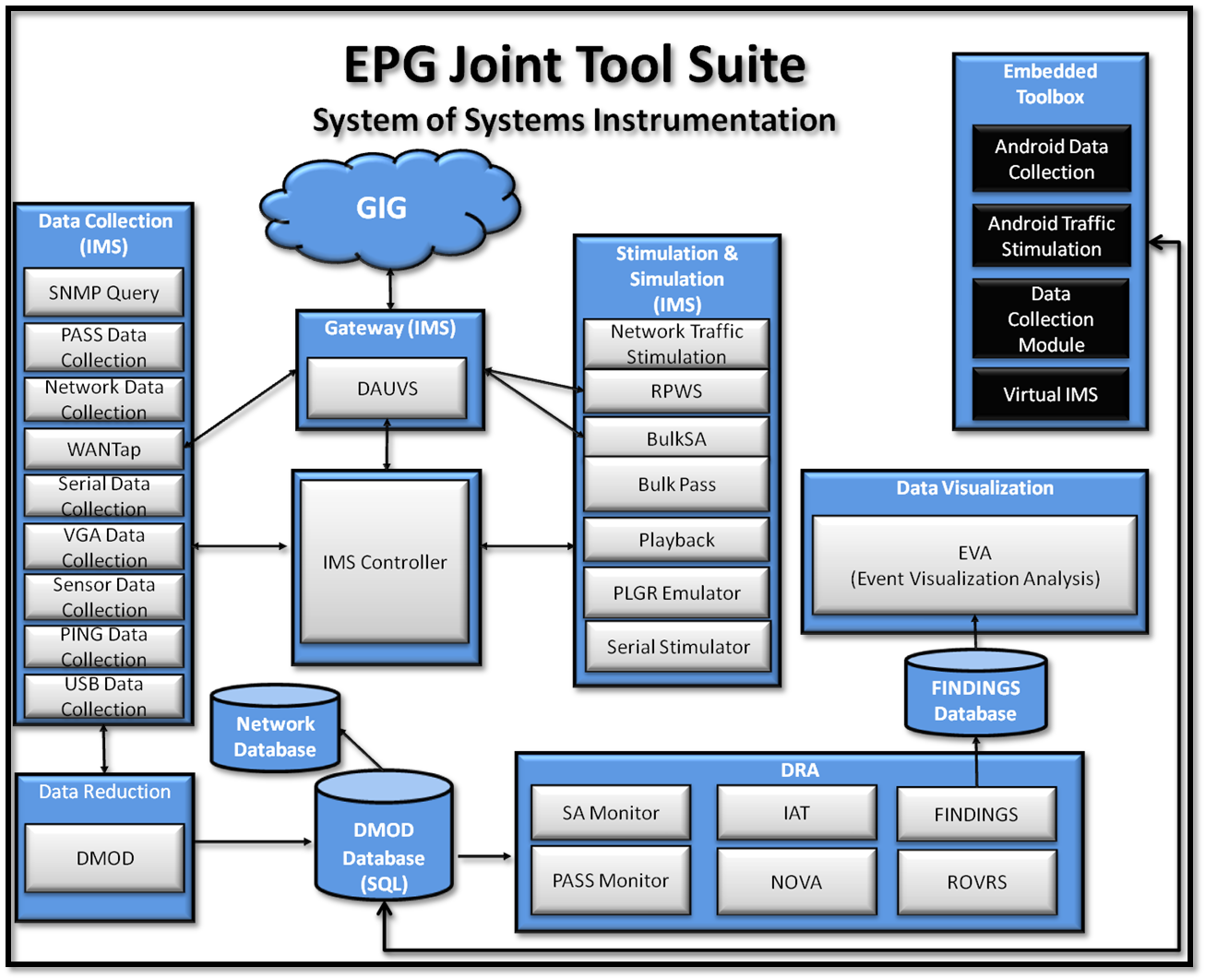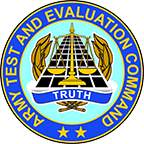- Homepage >
- Instrumentation >
- EPG Joint Tool Suite
EPG Joint Tool Suite

Instrumentation Management System (IMS) is a set of software services used to monitor and test communications systems.
Network Traffic Stimulation (NTS) generates messages used to stimulate LAN systems.
Bulk Publish and Subscribe Services (Bulk PASS) creates, subscribes, and publish PASS topics to an Army Battle Command System (ABCS) Information Services (AIS) Server, Maneuver Control System (MCS) Battle Command Server (BCS), MCS (Gateway) EZ-PASS Server or a Data Dissemination Services (DDS) Server according to the architecture.
Publish and Subscribe Service (PASS) Data Collection configures and controls information collected from an Automated Information System (AIS) Publish and Subscribe Service (PASS) server and / or a Data Dissemination Service (DDS) server.
Playback replays a log file back into the network at various speeds.
Serial Traffic Stimulation generates strings of ASCII characters used to stimulate serial data connections.
Voice AFT Controller manages the Automatic File Transfer (AFT) application which is used to automatically send and record sample voice files.
Network Data Collection (NDC) gathers all packets traversing a LAN.
Ping Data Collection generates pings, two per cycle, to multiple Ethernet-connected devices and is used to determine and monitor device and network health.
Sensor Data Collection gathers and displays data from sensor devices.
Serial Data Collection (SDC) gathers ASCII data that is transmitted and received across serial connections in six data formats, Raw Data, Compressed Serial Link Internet Protocol (CSLIP), Abbreviated Serial Link Internet Protocol (ASLIP), Blue Force Tracker (BFT), uPIED, and Encrypted Blue Force Tracker (eBFT).
Simple Network Management Protocol Data Collection collections network information from SNMP agents.
User Read-Out (URO) Data Collection simulates the URO device connected to the Enhance Position Location Reporting System (EPLRS) to input subnet assignment characteristics and send indirect communications routed through the Network Control System or direct communications over a previously established local sub network.
USB Data Collection (UDC) unobtrusively gathers Ethernet data from a Universal Serial Bus (USB) device or to collect raw USB data packets. Used in conjunction with additional hardware device called a Beagle.
VGA Data Collection (VDC) gathers screen shots from computers with Video Graphic Adapter (VGA) displays. Collection speed is configurable.
WAN Data Collection (WDC) inconspicuously gathers data from Wide Area Network (WAN) locations.
Role Player Workstation (RPWS) Configuration is a service used to setup the configuration used by the RPWS application.
GPS provides time and position information and uses the T2P2 PCI, T2P2 ISA, GPS Pulse-Per-Second Adapter (GPA), MPGPA, Portable Rugged Obtected (PRO) USB GPA, Network Time Protocol (NTP) Time Server, or Persistent Timekeeper hardware.
DCM Controller configures the DCMs collection parameters and transmits the information back to the DCM Receiver.
DCM Receiver receives the files that are being transmitted from the DCM.
Data Collection Module (DCM) collects data from systems under test that are files of interest to analysts, screen captures, and system information. The data collected by the DCM is transferred to the DCM receiver system. The DCM is installed directly on the system under test as a service. The product allows an existing controller service to communicate and configure the collection of data from a system.
Role Player Workstation (RPWS) is a component of the federation that provides for user-interactive Command and Control (C2) message creation and response for any number of designated simulated entities.
Data Processing Unit – Modular (DMOD) is a scalable software application that reduces level 1 instrumentation data from many sources to level 2 databases (SQL Server).
Event Visualization & Analysis (EVA) provides a visualization of data from multiple data sources. This visualization allows the user to see how well a particular test performed over time, as well as the capability to look for explanations why either the platforms in the test or parts of the network did not perform well.
Realistic Network Traffic Load Scenario Generator (RNTLS) is a desktop application used to create script files for other network testing software such as the Network Traffic Stimulation (NTS) service provided in the Instrumentation Management System (IMS) network testing software suite.
Multi-spectral Ambient Noise Collection and Analysis Tool (MANCAT) is a software package which provides ease of use in collecting RF Spectrum Data and providing mechanisms to perform analytics and problem solving to the resulting data.
Android Generator (AGEN) is an embedded Android Service that runs on Android Operating System (OS) devices. It is used to stimulate a rifleman radio network with binary data that currently can only be received and processed by other AGENS.
EPG Collect is a powerful tablet or phone-based replacement for conventional paper forms that can collect a variety of data types: text, location, photos, video, and audio. It is based on the Open Data Kit and uses the ActionBarSherlock library.
Data Reduction and Analysis (DRA) provides near real-time and post-test data reduction, analysis, and presentation capabilities to the test community using data collected from military platforms, typically Tactical Battle Command System or BCTM architectures instrumented with U.S. Army Electronic Proving Ground (EPG) data collection services. DRA uses a plug-in architecture to reduce, monitor, analyze, and report on message traffic, network data, friendly/enemy situational awareness (SA), and much more. Figure 1 depicts DRA with the various plug-ins and its relationship to the EPG Command, Control, Communications, Computers, Intelligence, Surveillance, and Reconnaissance (C4ISR) Test Tool Kit (TTK).
NOVA is an extensible markup language (XML) driven plug-in that provides users with bandwidth information based on data collected by the Electronic Proving Ground (EPG) data collection services processed by the Data Processing Unit (DPU) or Data Processing Unit-Modular (D-MOD).
Findings is a data analysis tool that performs reduction on network traffic and generates comprehensive reports and graphs based on Message Completion Rate (MCR), Speed of Service (SoS), message types/sizes, exception, Serial Generator (SGEN)/Traffic Generator (TGEN) expectation, and many more.
ROVRS is a flexible, near real-time or post-analysis database visualization tool. The plug-in allows users to create dynamic data views, custom reports, build simple to complex data filters, and provide input and/or output field translations.
SA Monitor aids in the analysis of SA positions by plotting units, platforms, entities, and tactical graphics onto a map from parsed data collected by the Electronic Proving Ground (EPG) data collection services. The application provides counts of active, stale, and old SA along with counts per data collection point and units/platforms of interest.
IMG Analysis Tool supports the display of video graphics array (VGA) screen captures, K05.19 entity data image attachments, and Data Model for Sensor (DMS) images captured via Tactical-Unattended Ground Sensors (T-UGS) or Urban-Unattended Ground Sensors (U-UGS).
PASS Monitor aids with the analysis of Tactical Battle Command System PASS and Data Dissemination Service (DDS) server extensible markup language (XML) traffic and is capable of supporting a multi-node DDS architecture. Besides message viewing, the plug-in validates PASS/DDS XML messages against approved published schemas and is capable of producing several types of detail/summary reports and charts.
Android Data Collector (ADC) is a software solution in the form of an embedded agent that provides a mechanism for data collection on devices with the Android Operating System. This solution is an Object Oriented program written in Java/Android. The system is comprised of a management front end referred to as an Activity, a service which is a background controller for broadcast listeners, a state listener, a common packet analyzer process, a Logcat collection process, and a timer class.
Starship II is an integrated software suite designed to facilitate and automate the command and control (C2) functions of test planning, test execution, and test status reporting in widely distributed test or exercise environments. Starship II enables a test director to plan a test, verify a test lay down, configure test instruments, initialize a test sequence, control and synchronize test events/resources, monitor status, provide quick-look analysis displays and reports, and report from the control or execution perspective.
StarGen is the planning tool portion of the Starship II suite of products. StarGen supports development and evaluation of systems under test as a one-box Test & Evaluation tool that addresses stimulation and testing domains.


